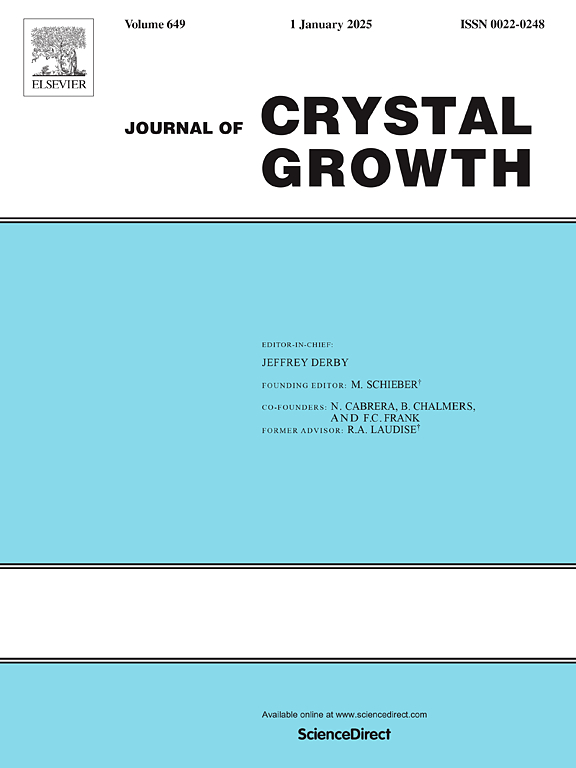ZnO-Nd2O3 nanocomposites: Solution combustion synthesis, structural studies and UV assisted photocatalytic degradation of paracetamol
IF 1.7
4区 材料科学
Q3 CRYSTALLOGRAPHY
引用次数: 0
Abstract
Solution combustion synthesis route was explored for developing ZnO-Nd2O3 nanocomposites/heterostructures along with pristine ZnO and Nd2O3 using tartaric acid as fuel. From the XRD (X-Ray diffraction) analysis, chemical identity and successful formation of heterostructures was ascertained. Average crystallite size, lattice parameters, microstrain and dislocation density values were evaluated from the XRD data, which were found to be in line with earlier reported studies and suggested the fusing of ZnO and Nd2O3crystallites to form bigger composite crystals. Surface characterization and grain size estimation was done using FESEM (Field Emission Scanning Electron Microscopy), which indicated that overall morphology and grain size of ZnO-Nd2O3 nanocomposites was an average of individual characteristics of ZnO and Nd2O3 nanomaterials. Elemental composition studies were carried out using EDS (Energy Dispersive Spectroscopy), which depicted the high chemical purity of as synthesized samples. Further, preliminary investigations were performed to assess the photocatalytic activities of as prepared samples by subjecting them to the UV assisted degradation of paracetamol. The ZnO-Nd2O3 nanocomposites were found to exhibit maximum photocatalytic efficiency followed by ZnO and Nd2O3. The high photocatalytic efficiency of heterostructures was attributed to the higher specific surface area and better separation of charge carriers mediated by Nd3+ ions. A very little loss of photocatalytic activity was observed for ZnO-Nd2O3 heterostructures when recovered and reused for five consecutive cycles, which was attributed to loss of catalyst after each cycle of recovery and preoccupied active sites of adsorption.
ZnO-Nd2O3纳米复合材料:溶液燃烧合成、结构研究和紫外辅助光催化降解扑热息痛
以酒石酸为燃料,探索了溶液燃烧合成ZnO-Nd2O3纳米复合材料/异质结构的方法。通过XRD (x射线衍射)分析,确定了异质结构的化学性质和成功形成。从XRD数据中评估了平均晶粒尺寸、晶格参数、微应变和位错密度值,发现这些值与先前报道的研究一致,表明ZnO和nd2o3晶体融合形成了更大的复合晶体。利用场发射扫描电镜(FESEM)对ZnO-Nd2O3纳米复合材料进行了表面表征和晶粒尺寸估算,结果表明ZnO-Nd2O3纳米复合材料的整体形貌和晶粒尺寸是ZnO和Nd2O3纳米材料各自特征的平均值。元素组成的研究进行了EDS(能量色散光谱),描绘了高的化学纯度合成的样品。此外,通过紫外辅助降解对乙酰氨基酚,对制备的样品的光催化活性进行了初步研究。ZnO-Nd2O3纳米复合材料的光催化效率最高,其次是ZnO和Nd2O3。异质结构具有较高的光催化效率,这主要归因于Nd3+离子介导的较高的比表面积和较好的载流子分离。在连续5个循环中,ZnO-Nd2O3异质结构的光催化活性损失很小,这是由于每次循环后催化剂的损失和吸附活性位点的占用。
本文章由计算机程序翻译,如有差异,请以英文原文为准。
求助全文
约1分钟内获得全文
求助全文
来源期刊

Journal of Crystal Growth
化学-晶体学
CiteScore
3.60
自引率
11.10%
发文量
373
审稿时长
65 days
期刊介绍:
The journal offers a common reference and publication source for workers engaged in research on the experimental and theoretical aspects of crystal growth and its applications, e.g. in devices. Experimental and theoretical contributions are published in the following fields: theory of nucleation and growth, molecular kinetics and transport phenomena, crystallization in viscous media such as polymers and glasses; crystal growth of metals, minerals, semiconductors, superconductors, magnetics, inorganic, organic and biological substances in bulk or as thin films; molecular beam epitaxy, chemical vapor deposition, growth of III-V and II-VI and other semiconductors; characterization of single crystals by physical and chemical methods; apparatus, instrumentation and techniques for crystal growth, and purification methods; multilayer heterostructures and their characterisation with an emphasis on crystal growth and epitaxial aspects of electronic materials. A special feature of the journal is the periodic inclusion of proceedings of symposia and conferences on relevant aspects of crystal growth.
 求助内容:
求助内容: 应助结果提醒方式:
应助结果提醒方式:


